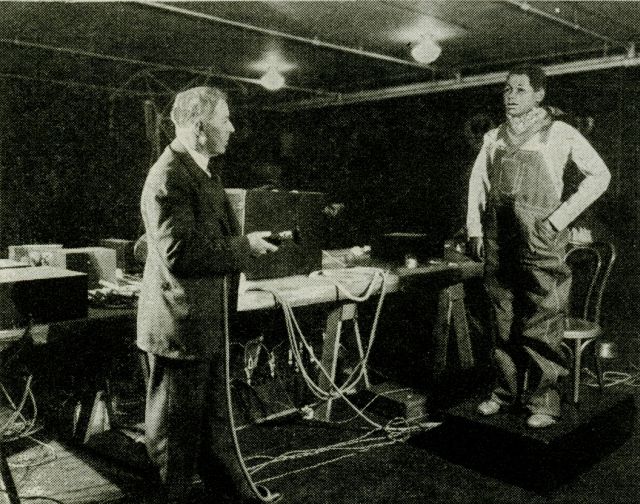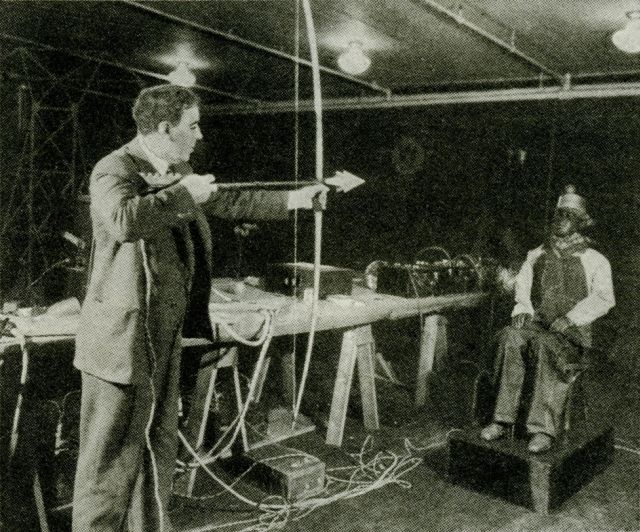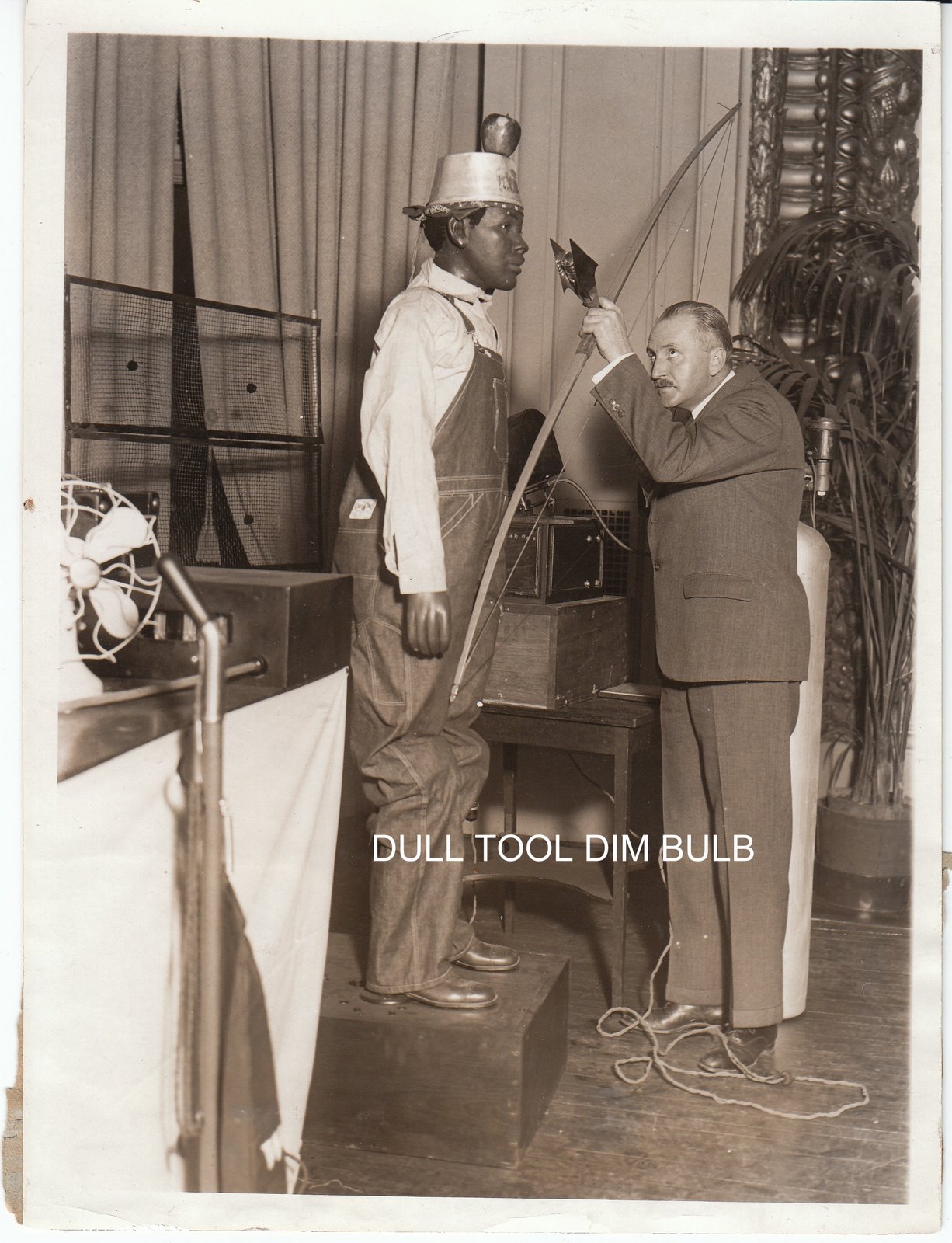
Above: Mr. 'Rastus Robot, the most lifelike of mechanical men, conducting a conversation with S. M. Kintner, assistant vice-president of the Westinghouse Co., Mr. Robot needs some prompting, it is true; that is given by the flashlight in his interlocutor's right hand, which controls the "sound-on-film" conversation previously rehearsed.

Here we have 'Rastus playing the role of the junior Wilhelm Tell. He has a rather strained air; and the shot will bring him to his feet with an exclamation of dismay. However, the shot will be made, not with the arrow itself, but with a beam of light. (Photos Westinghouse Electric & Mfg. Co.)
The above two images and the Radio-Craft article courtesy of Linda Paulsen, Thomas Mittelstaedt , and Mark Durenberger from the Pavek Broadcast Museum http://www.museumofbroadcasting.org/
Radio-Craft February 1931 (p469,509)
Mr. 'Rastus Robot
During the electrical and radio exhibitions of the past season, the increasing perfection of those mechanical servants, now popularly called "robots," has been the most spectacular feature. One of the finest yet produced, for human appearance and versatility, is "'Rastus," who is illustrated on the opposite page. He has the powers of speech, of using his hands, of rising and sitting—although, to date, the complicated maneuvers of walking seem to have been a little too much for biped automatons.
(Continued on page 509)
The signals, from which the talented gentleman from East Pittsburgh takes his cues, are given by means of light. The operator who directs his motions is armed with a control tube containing a neon lamp, which is modulated at audio frequency. Throwing the light from this on the proper photo-cell operates the desired relay in the robot. Within its figure is a miniature talking-movie equipment; that is to say, a 16-mm. projector, containing film with appropriate speeches in sequence on the sound track. This is operated at the proper time, and gives 'Rastus a very copious vocabulary- in a rich, baritone voice. A green light operates this sound apparatus, and a red light the motor equipment. This talented performer made his debut before the A.I.E.E, under the chaperonage of L. W. Chubb, research director of the Westinghouse laboratories.

Built by Dr. Phillips Thomas and S. M. Kintner in 1930. He moves (stands up or sits down, bows), talks (6 word vocabulary or sequences), and a photo-electric cell in his head , when activated by a light, in this case a beam from the arrow, is triggered, a gunpowder charge blows the apple off his head. His skin was made from rubber.
The picture above is one one the sharpest I've seen of Rastus. Quite a bit of detail can be gleaned from this. The photo was found on Jim Linderman's web page. The apparatus behind him is the "electric-eye" fire extinguisher.
.jpg)
[Note: The above article spells Kintner's name incorrectly as Kitner .]
from San Antonio Light 06 Sep 1931
RASTUS
The cells can be usedf to start, stop or blow up anything at any distance to which a beam of light or shadow can be thrown, Mr. Kintner performed a modernized version of William Tell and the famous shooting of the apple from the boy's head. In this case the boy was the dummy of a negro; and instead of shooting the arrow, he merely had to point it at the dummy's head. There was a lamp on the arrow which directed a beam in the direction it was aimed. As soon as that light fell on the eyes of the "boy," in whose hollow skull were photo-electric cells, the apple blew off his head by an explosion of gunpowder. The point of the William Tell story was the danger of missing the apple and killing the boy, but with Mr. Kintner's contraption there would have been nothing to it, he could not have missed.
Syracuse Herald 06 May 1935 p3
……………….Rastus Robot, the mechanical man, is the star performer of a demonstration and lecture in charge of Dr. ? Maxwell, of the Electrical Circus. This circus, which amazed throngs for two seasons of the World's Fair, opens with the manufacture of 250,000 volts of artificial lightning, zigzaging from a generator across insulators on a dwarf power transformer tower. The flash has a duration of five-millionths of a second. In a modern version of the William Tell legend, a beam of light shoots an apple off Willie. Jr.'s head—Willie. Jr. being a mechanical boy similar in his mysterious workings to Rastus Robot.
[Note: another occurance of Willie Jr and Rastus from 1935. It's one of two articles I've seen that ever mentions Willie Jr, the boy similar to Rastus. So Willie Jr is another Westinghouse robot only just discovered! There is a possibility that Telelux was eventually called Willie Jr.]
Another article (1930) refers to Rastus Robot as Doctor Thomas' "mechanical slave". Maybe by 1935 Rastus Robot, the negro mechanical slave is becoming politically incorrect already.